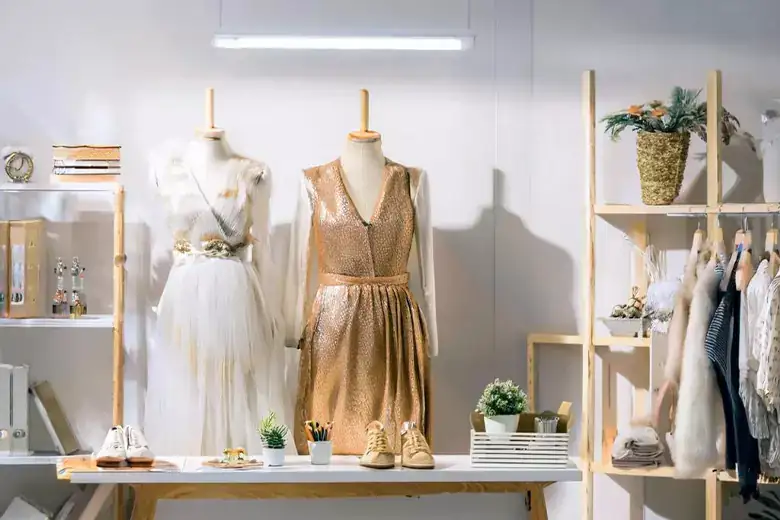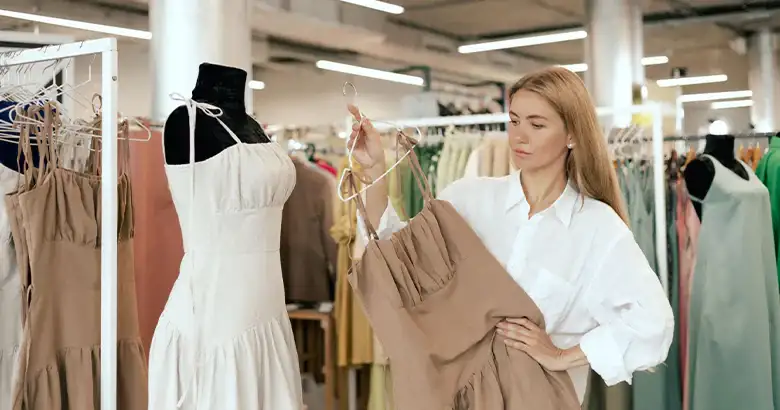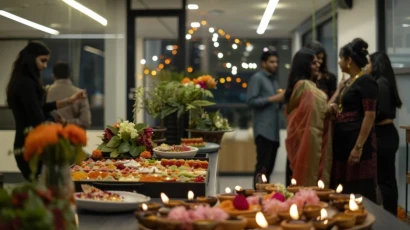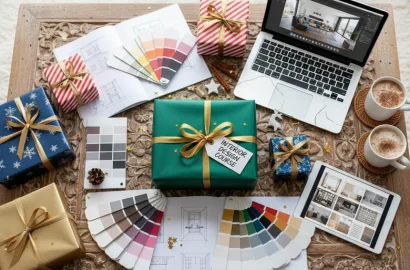Thinking of launching a career as a visual merchandiser? We’ve got all the steps you need to take, plus the skills and tips you’ll need for success.
Are you looking to launch a creative and fast-moving career that combines design, marketing, and customer psychology? If so, a role as a visual merchandiser could be for you. Crafting visually engaging retail environments and seamless, delightful customer experiences, a visual merchandiser uses their creative vision and hands-on skills to directly impact in-store experiences and bolster sales.
In this article, we’ve got everything you need to know to launch a career in this varied and rewarding industry- from defining the role and its responsibilities to outlining the top skills you need to have under your belt to succeed. We also provide a step-by-step guide to launching your career so that you can stand out from the competition and land a role you’ll love.
Here’s what we’ll be covering:
- What is a visual merchandiser?
- What are the key responsibilities of the visual merchandiser?
- Top skills of a visual merchandiser
- How to become a visual merchandiser
- Tips for succeeding as a visual merchandiser
- Conclusion
Ready to learn more about this exciting field? Then let’s dive in.
What is a visual merchandiser?
Have you ever walked past a beautifully designed shop window display and wondered who put it together? The person responsible for this is called a visual merchandiser. The role involves organizing, arranging, presenting, and displaying products in the windows of shops and throughout the retail space in an eye-catching and attractive way that reflects a brand’s image and aesthetic.
While visual merchandising is traditionally associated with physical retail stores on the high street, the role is now frequently applicable to so-called digital storefronts too. Combining color, lighting, space, sound, technology, and (in physical retail spaces) even smell, a successful visual merchandiser’s goal is to pique the customers’ interest and demonstrate in a memorable way the products and services the store offers.

What are the key responsibilities of the visual merchandiser?
If you think that a visual merchandiser spends most of their time dressing mannequins, then think again. This complex role incorporates skills in design, branding, marketing, sales, and user research to create compelling retail environments. Let’s take a look at some of the main tasks and responsibilities expected of a visual merchandiser.
1. Designing window displays
Using their knowledge of target customers, design theory, and retail and visual trends, a visual merchandiser is responsible for designing a shop’s window display. This is a key promotional space for new products and timely offers.
The visual merchandiser creates sketches or mock-ups of the display, often accompanied by a data-backed strategy. This approach seeks to demonstrate how the window design aligns with the brand’s visual design and the shop’s existing style while drawing in customers.
If a shop has multiple locations, the window display design may include variations on the same theme. If it’s a small project with a limited budget, the visual merchandiser may be responsible for sourcing materials, preparing the space, and physically implementing the new design, too.
For brands that have larger budgets or more ambitious window display ideas, however, the visual merchandiser may design the display and employ a larger team of creatives to implement it.
2. Organizing in-store layouts
While many people imagine visual merchandisers to be primarily focused on window displays, a large part of their work actually involves the design of in-store layouts.
Their goal here is to guide customers through the store effortlessly, draw their attention to key products and promotions, help them find what they are looking for, and support the seamless movement of people from one section of the store to another.
When it comes to high-demand or seasonal items, the visual merchandiser is also responsible for ensuring that they capture the customer’s attention by placing said items in strategic positions throughout the space.
Visual merchandisers often work closely with store managers on the layout of a retail space, gathering insights about shopper behavior and ensuring alignment with the brand’s identity.
When conducted successfully, the visual merchandiser’s design, organization, and arrangement of a store should make the customer journey feel easy and intuitive while encouraging longer visits and more purchases.
3. Choosing product placement and arrangements
Visual merchandisers are often responsible for shelf planning, displays, product arrangements, and product placement. This involves creating a strategy that ensures goods are placed throughout the store in a way that maximizes how much attention a customer gives to them. These products are then arranged in an attractive or entertaining way to further incite curiosity from customers and prompt more purchases. Some commonly used product placement and arrangement strategies include the following:
- Placing best-selling or high-margin products at eye level
- Grouping similar products together to encourage cross-selling (known as “zoning”)
- Endcap displays, whereby promotional items are placed at the ends of aisles to attract customers’ attention
- Creating themed displays, for example, “Back-To-School” or “Halloween”
- Arranging products vertically to create a more dynamic display
- Organizing products by their colors (known as “color blocking”)
- Creating focal points of standout products
- Placing complementary items together to boost sales
4. Incorporating branding elements into displays
A core responsibility in visual merchandising is incorporating key branding elements into window displays and in-store spaces to reflect and reinforce the brand’s visual identity. Using logos, colors, fonts, and images, the visual merchandiser ensures the brand’s overall aesthetic is represented throughout the store.
This important task not only creates a more cohesive shopping experience that resonates with customers, but it creates an environment where customers feel a stronger emotional connection to the brand. When done effectively, incorporating branding elements into displays enhances a customer’s loyalty to the brand and even influences or reinforces purchasing decisions.

Top skills of a visual merchandiser
If you’re thinking of becoming a visual merchandiser, what are the core skills that you need to succeed? From creativity to software skills, this is a role that requires a varied skill set, some of which we cover below.
1. Creativity
Creativity is an absolutely essential skill of the visual merchandiser. Clients (stores, supermarkets, retail spaces) look to them to transform a space into a visually engaging environment that captures customers' attention, shows products in their best light, and captures the very essence of the brand.
To make the space and goods look as appealing as possible, the visual merchandiser comes up with innovative ideas using unusual colors or patterns, interesting fabrics and materials, and fresh and exciting layouts that intrigue and inspire.
Increasingly, visual merchandisers are also incorporating cutting-edge technology and even animatronics into their displays to ensure a store’s products stand out from their retail competitors. By pushing their creative boundaries and thinking outside the box, visual merchandisers encourage customers to explore the retail space and purchase more goods.
2. Attention to detail
To ensure a visually appealing, cohesive, and aesthetically pleasing display of goods in the retail sector, attention to detail is an absolute must. By honing in on the details of a window or in-store display such as signage, lighting, and arrangement of props, the visual merchandiser ensures these elements all positively contribute to the customer’s overall experience in the store and their impression of the brand.
As well as being responsible for an immaculate space and a polished, engaging display, a visual merchandiser needs to be quick to notice and fix any errors, inconsistencies, or product defects. This is an important part of the role as any oversight in the display could negatively impact the overall impression it has on the customer. This might lead them to shopping elsewhere, or, worse, leaving a negative review.
Examples of flaws that can be easily overlooked include the following:
- Unevenly placed items
- Visual imbalance
- Faded or used-looking items
- Damaged products
- Mismatched colors
- Off-brand visuals
Additionally, a visual merchandiser is responsible for instructing retail staff on how to maintain displays and keep them looking tip-top. This helps to ensure an ongoing positive experience for customers.
3. Consumer knowledge, understanding, and empathy
As anyone who works in the field of design will tell you, knowing your users (or, in this case, customers) is at the heart of the job. This is no less true for visual merchandisers. A visual merchandiser must conduct extensive research into a store’s customers to understand their preferences, needs, buying habits, and more. This data informs how and where the visual merchandiser showcases the brand’s goods to most effectively speak to shoppers and encourage engagement and sales.
While a store will share its own knowledge of customer behavior and trends with a hired visual merchandiser, the latter (whether self-employed or part of the in-store team) is also responsible for conducting in-depth research to inform their visual displays. As design professionals, they have a range of methods and tools at their fingertips for getting to know a brand’s core audience and customers. Some of the methods they use include the following:
- Customer feedback and surveys
- Sales data analysis
- Customer demographics
- Competitor comparison and research
- Observation of customers in-store
- Trend analysis.
Using these research methods and tools, visual merchandisers can gather insights to create the most impactful and beneficial store experience for customers.

4. Knowledge of design and retail trends
Trends in design, retail, and customer behavior are evolving all the time. A visual merchandiser needs to be well-versed in current design, customer-related, and retail trends to best engage customers and boost sales. With this in-depth knowledge, they can:
- Incorporate the latest styles and concepts into their displays
- Keep the store fresh and appealing to modern shoppers
- Help a store maintain a competitive edge
- Adapt strategies to meet evolving tastes and expectations
- Stay in line with market demands
But how does a visual merchandiser stay up to date? Luckily, there are numerous sources they can gather data and insights from such as:
- Retail and design trade shows
- Digital and print fashion and design publications (blogs, magazines, journals)
- Social media as well as fashion and retail influencers
- Professional trend forecasting services like WGSN or Trendstop
- Retail industry and influencer-led podcasts
5. Technical skills in design software
While creativity, attention to detail, and passion for the industry are vital to the career success of a visual merchandiser, technical skills in design software are increasingly becoming must-haves for those wanting to climb the ladder in the industry.
Design tools for visual merchandisers cover a wide range of areas, but most commonly they will require tools to support graphic design, photo editing, illustration, creating print materials, designing store layouts, signage and logos, virtual displays, floor plans, store layout visualization, client presentations, and furniture and product placement.
Ranging from basic design to complex 3D modeling, these are some of the top tools in the industry that help visual merchandisers plan, visualize, collaborate, and execute their ideas.

How to become a visual merchandiser
Let’s take a look at the steps you need to take to launch a career as a visual merchandiser. With the right education, experience, and portfolio, you’ll be in a strong position to succeed in this competitive but highly rewarding industry.
1. Get an education in visual merchandising
While it’s possible to enter the field of visual merchandising without explicitly studying the topic, getting an education in the field will give you a strong advantage when it comes to the job market. Irrespective of the learning route you take, a structured education will set you apart from other candidates, boost your confidence, provide internship opportunities, hone your skills, support portfolio building, and provide you with the theoretical understanding you need to make successful design and display choices. Finally, a certificate from an accredited institution is likely to impress employers and demonstrate your commitment to this career choice.
When it comes to learning about visual merchandising there are a few options open to you:
- A university degree in visual merchandising: a theory-based approach
A degree in visual merchandising usually takes 3 to 4 years to complete and can often be studied full-time, part-time, and sometimes even online. Students come away with a deep knowledge of the theory behind visual merchandising and some real-world experience (via internships and work experience opportunities). Students also receive a recognized Bachelor’s degree certificate.
- Design school or community college diploma in visual merchandising: a more hands-on, focused approach
Most visual merchandising diplomas can be completed in 1 to 2 years, or 2-3 years part-time. Depending on the institution, these can be undertaken full-time or part-time with in-person, hybrid, and online study options. Many design schools offer well-equipped workshops and industry partnerships to give students practical experience in retail and design.
- Online course via an accredited provider: a comprehensive and flexible approach
Online courses vary significantly from provider to provider. While a short-term course might take between a few weeks and a few months to complete, other online providers offer self-paced learning which gives students up to 6 months to finish the program. Part-time and full-time options are almost always available with online courses. Many online courses offer flexible payment and study options, intensive portfolio-building assistance, career support, and a certificate of achievement.
2. Gain relevant industry experience
Gaining hands-on experience is crucial to learning how to apply the knowledge and skills of visual merchandising. While many degrees, diplomas, and online courses will offer students the opportunity to undertake work experience or an internship, those who choose not to undertake formal education will need to ensure they gain this crucial industry experience in some other way. It’s highly unlikely, irrespective of an individual’s personal passion or knowledge of the industry, that an employer or potential client will take a risk on a visual merchandiser who has no hands-on experience in the field.
Luckily, there are several ways to get practical experience in visual merchandising. Not only will this look great on your CV, it will cement your skills, and boost your confidence when you are ready to apply for your first positions.
The following are just some of the ways you might gain some industry experience:
- An internship
An internship is an unpaid full or part-time opportunity to work with experienced professionals in visual merchandising. Typically ranging from a few weeks to several months, they are offered by many major retailers, design agencies, and fashion brands to students or early-career professionals who are looking to gain exposure, build practical skills, and learn more about the field.
- Shadowing a visual merchandiser
Shadowing a visual merchandiser involves following, observing, and assisting a visual merchandiser as they meet clients, visit stores, design store layouts, and assemble displays. This is an opportunity for a student or early-career professional to gain real insight into what the role involves on a day-to-day basis.
- Entry-level position in retail or merchandising
An entry-level or assistant position in retail or merchandising is a great way to learn about the environment in which a visual merchandiser works. Such roles provide valuable hands-on experience while enabling an individual to learn more about customer behavior and different merchandising strategies and techniques.
3. Build a portfolio
Your portfolio is your ticket to finding work as a visual designer. Rather than just filling it with every project you’ve ever completed, prioritize your very best work and the projects you’re particularly proud of. Consider including projects you’ve completed as part of a course, an internship, a freelance gig, or when you’ve assisted a professional visual merchandiser.
When creating your portfolio, focus on demonstrating your design, organizational, and execution skills. You should also consider adding notes that articulate how your visual displays connect with customers, align with retail trends, and meet stated business objectives.
4. Apply for your first positions
Once you’ve got a solid foundation in visual merchandising theory, feel confident in its application, and possess a strong portfolio of your favorite projects, you’re ready to start applying for your first positions in the field.
It’s wise to aim for entry-level or assistant positions at this stage as these will give you a chance to learn from other professionals in the field and grow your skill set further. Be sure to craft personalized applications demonstrating your passion for the particular role being advertised and emphasize in your cover letter why you’d like to work for the particular company.
Rather than repeating your CV in your cover letter, try to focus on the value you will bring to the company or the team. By avoiding a generic approach, focusing on the role on offer, and demonstrating a passion for the industry, you’re more likely to stand out from other applicants.
You’ll find job advertisements for visual merchandising entry and assistant roles on the following job boards:
- Retail Jobs Web
- RetailChoice
- CreativeHeads
- Design Jobs Board
- Fashion United Jobs
- The Dots
- CreativePool

Tips for succeeding as a visual merchandiser
If visual merchandising sounds like a career you’d like to get into, how do you ensure you stand out from the crowd? Follow our tips to gain a competitive advantage.
1. Stay up to date on retail trends and design innovations
Using resources such as industry publications, blogs, and podcasts, it’s easy to stay up to date on the latest retail trends, customer preferences, and design innovations that shape the industry and your priorities as a visual merchandiser. By staying up to date, you’re a more attractive prospect to employers who will be looking to tap into both customer and retail trends to boost sales and enhance the overall shopping experience.
2. Develop a strong network in retail and fashion
While networking is an important skill in many industries, in fashion and retail it’s a non-negotiable. By attending industry events such as panel discussions, summits, design fairs, conferences, innovation events, trade shows, networking events, and expos, you have the chance to:
- Learn more about the industry
- Meet like-minded professionals
- Be the first to hear of job vacancies and career opportunities
- Connect with and learn from leading industry figures
- Build a strong professional support network
- Get ahead of trends
- Get your CV in front of hiring managers
- Make an impression on recruitment teams and leading outlets
- Learn from other visual merchandisers
3. Be adaptable
Due to the fast-paced and dynamic nature of the retail and fashion industries, it’s vital to be adaptable as a visual merchandiser. Just some of the reasons why you can’t remain static in this role include:
- Constantly evolving trends
- Changing retail environments
- Unpredictable consumer behavior
- Collaboration with wide-ranging teams
- Budget constraints
- Emerging technology and tools
- Seasonal trends
- The growth of omnichannel retailing (where a customer’s experience with a brand spans on and offline environments)
For all of these reasons, a visual merchandiser needs to keep adaptability and flexibility at the heart of the role. This enables them to stay relevant in an industry that is evolving at lightning speed, respond to new trends, incorporate new technologies, and meet shifting business needs.
Conclusion
If you’re passionate about design and want to use your creative skills in a rewarding role, becoming a visual merchandiser in the retail industry can be a highly fulfilling career path.
As we’ve seen, you’ll need a strong educational foundation, hands-on experience, and a strong portfolio to get started in the industry. To stay competitive and advance your career, it’ll be important to use networking opportunities, an adaptable approach, and awareness of trends.
Whether you're just starting out in the industry or looking to elevate your existing design career, the world of visual merchandising offers countless opportunities for creative expression and professional growth.
Next Steps
If you enjoyed this article and would like to learn more about interior design, head back to AND Academy’s blog for more articles like this one. We also recommend you check out this project by AND Learner, Sonali Khajuria to get inspiration for your next interior design project.
In case you need further assistance, here are some resources to consider:
- Watch this session by Snehanshu Mukherjee, Founding Partner at T.E.A.M and Mansi Almadi, an Interior Designer at Studio Lotus
- Talk to a course advisor to discuss how you can transform your career with one of our courses.
- Check out our Interior Design courses - all courses are taught through live, interactive classes by industry experts.
- Take advantage of our scholarship and funding options to overcome any financial hurdle on the path of your career transformation.
Note: All information and/or data from external sources is believed to be accurate as of the date of publication.










